The Song-Sayer’s Lament is set around the year we would now describe as 540 AD, in Sixth Century Dark Age Britain, and I wanted to mark the passage of time for my characters in a way that might be credible for the period in question. Why? Because, in truth, we have no idea how Britons, in the century after the Romans left our shores, calculated their calendar.
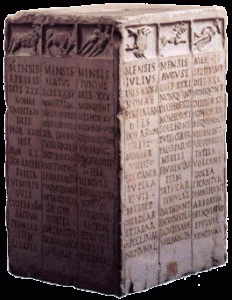
It’s worth noting at the outset that even the Anno Domini system was not then functional, since it did not come into common use until much later, in the Eighth Century (although probably invented initially in the Sixth). At the time, the late-Roman Empire was still using the Anno Urbis Conditae (AUC) system – basically, Rome Foundation Year – or simply the regnal year of the Emperors themselves. So, depending on the source, 540 AD could have been known, even in official circles, variously as 1293 AUC, or 292 AUC, Second Millennium, or simply Year 18 (Emperor Justinian’s regnal year) or, for Christians, the Third Year of Pope Vigilius. And locally? Possibly just the year number from which your local warlord might have seized power. Or from some other significant event. Yet I had a nagging suspicion that the British Celts, with such a rich lore (oral or otherwise) might have enjoyed their own Foundation Year notion for their lands. Well, we may never know. But we can be a bit more certain about how each year was actually structured? I turned to sites such as Dolores Whelan’s blogsite, www.doloreswhelan.ie (Celtic Year) and the www.tansceltic.com pages for a broad idea and cross-checked the details against some of the source books listed below – and then, of course, attempted to use my etymological resources to put the names of festivals into my Cousins’ Tongue.
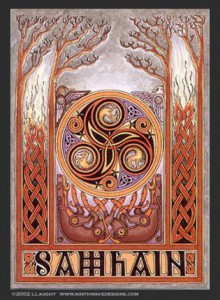
So, where to start? At New Year, naturally. The end of the year’s Light Half. And New Year, for my characters, begins on the first day of November – the Calends of November, as I call it, using the Roman name for that part of the month as, I imagined, Britons of the period may have done after 400 years of colonisation by the Roman Empire. This is the festival in the Gaelic-Celtic calendar usually known at Samhain, or similar, and which I’ve chosen to translate (as others have done) as Summer’s End. My Summer’s End Festival involves plenty of feasting, naturally, and the lighting of healing bonfires, between which the breeding stock for next season – sheep, goats, pigs and cattle – would be run, between the flames, to seek the blessing of the Three-in-One, the gods Epona, Kernuno and Lug.
And then, as the Dark Half deepens, late in December, comes the Midwinter Sun Standing (Solstice), and the Roman Festival of Saturnalia, just a few days before celebration of the Invincible Sun on the day of Mithras-Birth itself. Sol Invictus. Mithras the Sun God is, of course, one of the main deities of the Roman world. Mithraism looked set to become the official religion of the Roman Empire until Constantine gave that valued place to Christianity in the Fourth Century. And there have been allegations ever since that Christianity “stole” much of its imagery from Mithraism – including, of course, the birth date of its principal personality.
At the beginning of Februarius comes the Cleansing. Imbolg in the Gaelic – Birth Cleansing Morn, as I’ve interpreted the festival. The Feast of Saint Brigid (or the goddess Brigida). The end of the First Quarter, the mid-point of the Dark Half. More bonfires, but this time with the flocks and herds driven from west to east, towards the gathering light of an almost invisible sun. And here’s how the narrator of my story, Meridden of Sea Fort, describes the day:
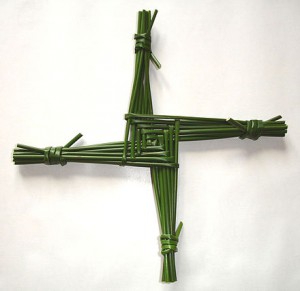
And if only Brigida could be induced to spread her holy light upon the livestock and the farming land, perhaps she might make us bountiful once more. Perhaps this year the Endless Winter might truly be banished. The goddess must surely know how hard these people had tried. Beds of straw had been plaited for her on the previous night, at Birth Cleansing Eve, in every byre and storage barn, each bed adorned with snowdrop heads and the white birch wand they hope she might use to dispense her blessings, with food and drink left alongside to succour her.
It had almost made me laugh, to see the desperation as family vied with family to appease this other deity, criticised their neighbours if they thought the offerings too meagre, the welcome bed insufficiently ornate. And even the monks were here to take their own share of the credit. For Holy Brigida, they claimed, had truly been a Christ-bride in Laigin, a miracle worker who cured lepers by a single touch, or dispelled disease with a single drop of blood from her finger, or brought forth magic waters from the living rock with just one tap of her staff. The Bishop of Laigin had declared her a saint, it seemed, after her death – a death that had occurred within living memory. Strange, then, that our people had been venerating the goddess for generations without number. But nobody seemed to mind. The monks’ prayers could surely not harm.
And inevitably, of course, there’s the feasting. Onion and kale cakes. Dumplings filled with slake and cockle-meat. Sweet bread too.
Close on the heels of Birth Cleansing Morn, just a few days later comes the ceremony inherited from the Romans, their Parentalia, on the Ides of Februarius, the Day of the Dead, when families may commune with the spirits of those they have lost. And their ancestors too.
Pascha next – the Passover Feast that begins with the first Sun’s Day following the Martius Equal Night (Equinox). In The Song-Sayer’s Lament, the Christ-followers celebrate Pascha as the Last Supper of the Martyrs while, for Mithras-worshippers, it marks the passing of Mithras into immortality, his ascent into Heaven. And even for the Saeson Outlanders, it is a sacred point in the year also, upon which they shower offerings to their old goddess, Eostra.
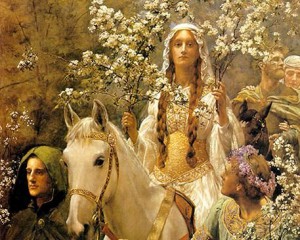
And thus we come to the year’s Light Half. It’s ushered in at Bright Fire Morn. Beltane in the Gaelic festivals. The Calends of Maius. Bushes are hung about with yellow flowers, ribbon and painted shells. Cattle are gathered, similarly adorned, then ceremoniously paraded towards the drove roads for the higher summer pastures. A great time for Annual Markets too. Vendors of skin, furs, cheeses and those clever Saeson jewellery imitations of precious gems and silver cell work. Hagglers of timber, leather and linens. Auctioneers of goats, hawks, ponies, hounds and slaves. Workers of tin and copper, wax, flannel, glass, shale and jet. Pedlars of pots and tiny figurine images for the gods – Taranis and Herne; Epona and Kernunos; Danu and Arawn; Lugos and Brigid; Mithras and Yesu the Christos.
Next, far into Junius, is the Midsummer Sun Standing (Solstice) and the longest day of the year.
After that, on the Calends of Augustus, Lug’s Day (Lughnasa) – the beginning of the Light Half’s Second Quarter. A harvest festival and, in our tale, the great annual celebration of all those beliefs prevalent among those not already converted to Christianity.
There were devotees below us from just about every faith I could name. Oak Seers, yes. In great
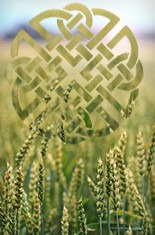
numbers. Carrying almost a walking forest of foliage. But Mithras worshippers too, with their makeshift wooden altars and miniature Mithraeums; Asclepians, bearing the famous staff with a symbolic snake wrapped about its length, or coloured flasks representing medicines and potions; Soterians, easily distinguished by their state of inebriation, even at this early hour; admirers of Priapus, displaying all manner of phallic symbolism, and dressed in the most outrageous costumes; strings of horses, decked with garland and ribbon in honour of Epona; the young women of Nymphae, daring in diaphanous blues, greens and reds; owl-masked followers of Minerva; and the wheels of chance that stood sacred to Fortuna.
Which brings us to the end of another year!
See how these festivals and celebrations help to shape The Song-Sayer’s Lament. And let me know what you think!
In the early Medieval period, British kingship was not inherited in a direct line from previous kings, as would be the case in the late Middle Ages. There were instead a number of candidates for kingship, who usually needed to be a member of a particular dynasty and to claim descent from a particular ancestor.
Apologies, but what is your primary source for this view? It seems very definitive when there’s little or no evidence to show that early Medieval Britons used the term “king” or “kingship” at all. On the other hand, if we accept the only potentially contemporary writer from the period, Gildas, as being genuine, we know that the Overlord/Chieftain of the territories later known as Gwynedd (Maelgwyn), passed his rulership down directly to both his son and grandson. We know from Roman commentators that the Britons had no “kings” before the Romans arrived – simply tribal chieftains of the many disparate peoples in Britain – and they certainly had no “kings” during the Roman occupation itself. Why would they have suddenly invented them after the Romans left and where is the evidence for that? Whereas, the Anglo-Saxon chronicles clearly show the way that “kingship” developed as Anglo-Saxon culture and identity developed and consolidated itself. Thanks for the post and interesting debate.